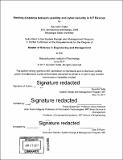Striking a balance between usability and cyber-security in IoT devices/
Author(s)
Dutta, Saurabh
DownloadFull printable version (12.33Mb)
Other Contributors
System Design and Management Program.
Advisor
Stuart Madnick.
Terms of use
Metadata
Show full item recordAbstract
Today more and more physical objects are being connected to internet. The Internet of Things, or loT, is dramatically changing the way of living and the way we interact with things and each other. Home doors can be opened remotely with a watch, cars' performance can be upgraded remotely, devices monitor health and send updates to physicians remotely. loT technology has made some labor-intensive jobs simple and has the potential to simplify and enhance nearly every aspect of our lives. On the other hand, increased levels of high profile cyber security breaches in recent years have made it clear how important it is to make sure these devices are trustworthy and secure. While most users are aware of how critical it is to secure their laptops, mobile devices, and apps, due to the seamless ways in which loT devices integrates into our daily lives, users are often unaware of risks associated with them. At the same time, IoT device makers are aggressively releasing new products in a mad race to establish themselves in this emerging market. Increased pressure to differentiate on usability based functionalities has spurred products and features that are not properly vetted for security. Gartner predicts that by 2020, more than 25% of identified enterprise attacks will involve IoT, though loT will account for only 10% of IT security budgets. As loT continues to grow, vendors will favor usability over security and IT security practitioners remain unsure of the correct amount of acceptable risk.
Description
Thesis: S.M. in Engineering and Management, Massachusetts Institute of Technology, System Design and Management Program, 2017. Cataloged from PDF version of thesis. Includes bibliographical references (pages 67-74).
Date issued
2017Department
Massachusetts Institute of Technology. Engineering and Management Program; System Design and Management Program.; Massachusetts Institute of Technology. Integrated Design and Management ProgramPublisher
Massachusetts Institute of Technology
Keywords
Engineering and Management Program., Integrated Design and Management Program., System Design and Management Program.